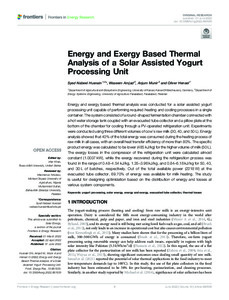| dc.date.accessioned | 2022-06-20T09:53:39Z | |
| dc.date.available | 2022-06-20T09:53:39Z | |
| dc.date.issued | 2022-06-01 | |
| dc.identifier | doi:10.17170/kobra-202206146341 | |
| dc.identifier.uri | http://hdl.handle.net/123456789/13927 | |
| dc.description.sponsorship | Gefördert durch den Publikationsfonds der Universität Kassel | ger |
| dc.language.iso | eng | eng |
| dc.rights | Namensnennung 4.0 International | * |
| dc.rights.uri | http://creativecommons.org/licenses/by/4.0/ | * |
| dc.subject | yogurt processing | eng |
| dc.subject | solar energy | eng |
| dc.subject | energy and exergy | eng |
| dc.subject | evacuated tube collector | eng |
| dc.subject | thermal losses | eng |
| dc.subject.ddc | 333 | |
| dc.title | Energy and Exergy Based Thermal Analysis of a Solar Assisted Yogurt Processing Unit | eng |
| dc.type | Aufsatz | |
| dcterms.abstract | Energy and exergy based thermal analysis was conducted for a solar assisted yogurt processing unit capable of performing required heating and cooling processes in a single container. The system consisted of a round-shaped fermentation chamber connected with a hot water storage tank coupled with an evacuated tube collector and a pillow plate at the bottom of the chamber for cooling through a PV-operated refrigeration unit. Experiments were conducted using three different volumes of cow’s raw milk (30, 40, and 50 L). Energy analysis showed that 40% of the total energy was consumed during the heating process of raw milk in all cases, with an overall heat transfer efficiency of more than 80%. The specific product energy was calculated to be lower (485 kJ/kg) for the higher volume of milk (50 L). The exergy losses in the compressor of the refrigeration unit were calculated almost constant (1.0037 kW), while the exergy recovered during the refrigeration process was found in the range of 0.48–4.54 kJ/kg, 1.35–3.96 kJ/kg, and 0.84–6.18 kJ/kg for 50, 40, and 30 L of batches, respectively. Out of the total available power (2218 W) at the evacuated tube collector, 69.70% of energy was available for milk heating. The study is useful for designing optimization based on the distribution of energy and losses at various system components. | eng |
| dcterms.accessRights | open access | |
| dcterms.creator | Husnain, Syed Nabeel | |
| dcterms.creator | Amjad, Waseem | |
| dcterms.creator | Munir, Anjum | |
| dcterms.creator | Hensel, Oliver | |
| dc.relation.doi | doi:10.3389/fenrg.2022.887639 | |
| dc.subject.swd | Joghurtherstellung | ger |
| dc.subject.swd | Sonnenenergie | ger |
| dc.subject.swd | Exergie | ger |
| dc.subject.swd | Energie | ger |
| dc.subject.swd | Wärmeverlust | ger |
| dc.type.version | publishedVersion | |
| dcterms.source.identifier | eissn:2296-598X | |
| dcterms.source.journal | Frontiers in Energy Research | eng |
| dcterms.source.volume | Volume 10 | |
| kup.iskup | false | |
| dcterms.source.articlenumber | 887639 | |


